Australia
Australia's Solar Race
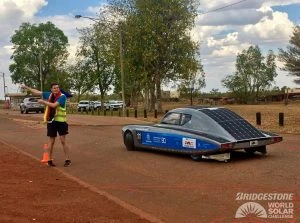
Solar Race Car
The ‘Nuon Solar Team’ continues to dominate the solar race across Australia that started in Darwin and will finish in Adelaide. Racing without conventional combustion engines, the various teams from around the world converged on Darwin having built their vehicles as completely solar-powered electric machines.
There are three categories that are completing the journey. The first being the quickest team to complete the 3000 km race distance – this race is known as the ‘Challenger Class’.
The second class is the known as the ‘Cruiser Class’, where there are points given to the teams for the number of passengers on board, the amount of energy that they are using in terms of the number of battery recharges that are occurring throughout the journey and the general practicality of the car. Being a part of the ‘Cruiser Class’, the points aren’t all about speed.
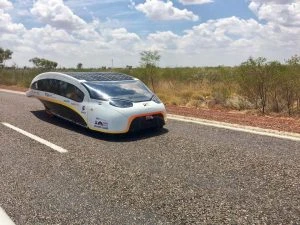
Solar Race Cruiser Class
Finally, the third category is known as the ‘Adventure Class’ which is the non-competitive class, allowing cars built for previous races of the event to run again – usually with new team members. The ‘Adventure Class’ can also be used as a catchment for those who, while meeting the exacting safety standards, may not have quite made full compliance with the latest race requirements. This is the category with the more laid-back travel style.
At the end of day three: the quickest team competing in the ‘Challenger Class’ is the ‘Nuon Solar Team’ from Holland.
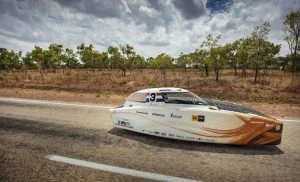
Nuon Solar Team
Second is the team from Tokai University.
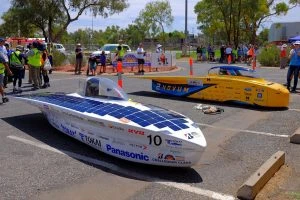
Tokai University Race Team
Third is the team from Michigan University.
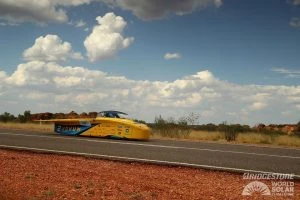
Novum Race Team
Just over halfway through the race and there will still be plenty of challenges ahead for all race competitors. One of the major influences on how well a car performs in this race is the amount of sunshine there will be. Cloudy days do impact the speed and progress of the cars.
This is an exciting race held here in Australia that is sponsored by Bridgestone, and it’s these sort of races that enable the evolution of production cars being run on electricity and solar energy. If you can, get out and have a look at the cars as they silently run into Adelaide in a few days time.
Auto Industry News – Q3 2017
We review all the major news events in the automotive industry from the third quarter of 2017.
Safety and Environment
In what became the first ever compulsory recall for vehicles in Australia, the ACCC intervened to shine the spotlight on cars affected by defective Takata airbags. The recall eventuated amid a rising number of fatalities worldwide attributed to the faulty components, including a local fatality in Sydney.
Emissions scandals continue to plague manufacturers, with Peugeot and Citroen being looked into for their alleged use of ‘cheating’ devices similar to those used by Volkswagen. The companies join Renault and Fiat Chrysler to be looked into, however, they have strongly denied the accusations. Also being accused of unconscionable conduct, Daimler is facing concerns it sold over one million cars with excess emissions.
In a boost for environmentalists, Queensland’s government announced plans to develop the world’s longest electric highway that will promote the use of electric vehicles.

Technology
Fuel technology continues to be a major focal point. Volvo has drawn a line in the sand, as the auto maker plans to begin phasing out petrol and diesel in the coming years. This aligns with legislation in France and the UK that will ban said vehicles from 2040, and China planning to soon ban the production of these vehicles, although Australia isn’t expected to follow suit any time soon.
Locally, the nation could be at the forefront of hydrogen fuel technology, with a world first trial set for hydrogen powered vehicles next year. South Australia even became the first Australian state to endorse hydrogen as the next fuel technology.
On a related note, Sydney will play host to integral trials surrounding the future of autonomous vehicles in Australia, while first round results from testing in Victoria suggest infrastructure and technology are currently ill equipped for self-driving vehicles. Abroad however, and vacuum cleaner maker Dyson is eyeing the electric vehicle market, set to take on dedicated manufacturers as soon as 2020.
Other technology developments include:
- Speakerless systems that use a car’s dashboard, seats and roof to transmit sound
- Mercedes Benz backing the future of flying cars
- Mazda announcing plans to develop the world’s first commercial petrol compression ignition engine

Legal and Regulatory Issues
The government was caught up in a vehicle ‘carbon tax’ controversy, with auto bodies and car makers slamming a rumoured proposal, although the government went on the front foot to deny its prospects.
Elsewhere, the ACCC commenced proceedings against Ford Australia over its ‘faulty’ auto transmissions, however the car maker announced it will contend the accusations. Also facing scrutiny from the ACCC, Holden settled an investigation by announcing the industry’s first vehicle refund and replacement scheme for the first 60 days of vehicle ownership
However, the ACCC saved its biggest salvo for the broader new car industry, detailing a wide range of concerns regarding the way customers’ complaints are dealt with, the sharing of manufacturer data with independent repairers, and real world fuel/emissions tests. The developments could give rise to lemon laws. Naturally, this provoked concern and consternation from the automotive bodies.
Finally, the Federal Court has requested Volkswagen publish changes to vehicle performance on its website and social media arising from the Dieselgate saga.
Holden: The Day For Closing Is Coming.
Holden, along with Toyota, will cease to manufacture cars in Australia. But how has the process leading up to that day been handled, what about the people involved? Private Fleet‘s Dave Conole had a one on one interview with the head of PR for Holden, Sean Poppit. This is part one of a two part story.
With Holden stopping manufacturing in Australia, what has been the process to wind down making cars up to the final day?
October 20 is the final day of production and we’ll continue building cars up until the final day and it will be full speed up until that point. Let’s say we’re doing 170 cars per day, we’ll stay at that figure right until the final day. Obviously that day won’t be a full production day and we’ll hold a private employee only ceremony at the plant to mark and honour our heritage and our people.
What is being done to support the workers across the factories?
At the plant in Adelaide we’ve got just under a thousand workers there. One of the things that has been ABSOLUTELY non-negotiable from us, right from the outset, have been what we call the transition services and the transition centres. Our HR and manufacturing teams have won several national, and in fact, global awards for the quality of that work.
We’ve got a full time transition centre set up at the Holden Vehicle Operations which is at our plant in Adelaide. We’ve fully decked out the bottom floor of one wing and that’s a dedicated, permanent , centre to assist people in getting new jobs or be retrained. We have independent people from many industries, government support including the military, people from the private sector like engineering groups…it’s been a benchmark piece of work and it’s something we’re justifiably and extremely proud of in the way it’s helped and continues to help people transition.
Up until this chat we’ve had an eighty percent success rate, meaning eighty percent of those that have left Holden since 2013 have found or gone onto new work, while that other twenty percent have either gone into full time study or chosen to retire. So it’s been an amazing success rate which I think is a testament to what we have in place to helping our people transition AND how eminently employable our people are.
That’s some really good news for the people involved, yes?
Absolutely. Not just in the north of Adelaide but in Adelaide itself Holden was seen as a job for life. It’s a great place to work, really fair pay, you get to work with a brand you are passionate about and get opportunities to move around the plant and do different roles. There’s lots of long term employees and we know it (the change) can be daunting to re-skill and re-train which really is the reason for being, these transition centres.
However there will still be roles for current employees, right, in places and roles such as Lang Lang or in research and development?
True. We’ll become a vehicle importer, engineering, and design centre and we’ll still have the second largest dealer network in the country. Our corporate HQ will remain here at Port Melbourne and there’ll still be our team of 150 designers as part of the international design studios and yes we’ll retain the Lang Lang proving ground (south east of Melbourne) and the 150 engineers on site there. What that means is there will be somewhere between 350 to 400 designers and engineers working on local and international products as well as the hundreds of people in the corporate side, sales, marketing etc.
With the new Commodore on the way, how does Holden see the vehicle being received?
We ran a drive day at the proving grounds earlier this year, with the next gen Commodore. We had the V6 and four cylinder version. We had a dozen Commodore customers there. I’ll be up front, we had a couple of them come up and question why they were there, saying yes they were keen to see the proving ground but didn’t have a lot of interest in a front drive Commodore.
(It’s here that Sean shared some quotes from those that attended.)
“I wouldn’t have considered this car, now I’d even consider the two litre, never mind the V6.”
“ I’m really surprised at how well it gets the power down, it feels quicker through the corners than expected.”
“The new Commodore is really impressive, I particularly like the V6 model with the all wheel drive, even the two wheel drive model is not bad and very quick with the turbo.”
It’s going to be on us to present the car in the right way, we don’t imagine for one second it’s going to have the same emotional and nostalgic appeal. Our sales numbers, we don’t expect it’ll sell in the same numbers the locally built car did. But what’s critical, and what was reinforced to us in a pilot program we ran recently…. what we want is for people to drive the car and understand that Holden magic, what made the Commodore so great, there’s a very, very big streak of it in this new car. Rob Tribbiani (Holden’s legendary chassis engineer and the driver of the Holden ute that set a record at the famed Nurburgring) is super excited about the all wheel drive V6 with the adaptive dampers and tricky real differential system, is a real belter. We just want the car to be driven and judged on its own merits.
How Will The Police Force Replace Their Fords and Holdens?
We all know that the Holden Commodore has been an Aussie icon on the roads for quite a few years now. We’ve also all seen Holden Commodores tricked out as police cars… sometimes a bit too close for comfort and sometimes as a very welcome sight indeed. If you are both sharp-eyed and lead-footed, then the sight and shape of any white Commodore of a certain age is enough to get you easing up on the accelerator and slowing down; the shape is burned into your brain like the shape of a hawk is burned into the brain of a chicken (yes, chickens actually do have brains).
It also appears that the red lion vs blue oval rivalry might be alive and well in the police force, as all the points above also apply to Ford Falcons, including the bit about the shape being burned into the brains of the lead-footed.
However, the doors of the Holden factory are closing. So are Ford’s, which means that if our police force wants to have a vehicle fleet that’s up to date, they need to look for another company. Naturally, car manufacturers around the globe have been eyeing up the contract of providing our police cars… and not just for the honour of the job but also for the very big bucks this sort of contract would entail.
So what are our boys and girls in blue going to be driving?
Rumours are flying thick and fast. Browsing through the Australian Federal Police and the NSW police websites don’t exactly yield a lot of information about what the new vehicle is going to be – it’s all kept very, very quiet. However, the rumour mill has popped up a couple of possibilities that could very well be in the running for what we’ll see on the roads sporting the disco lights and with the word POLICE proudly emblazoned on the side (hopefully not pulling up your driveway when you hadn’t dialled 000).
It’s not easy being a cop car. A cop car has to have great handling and plenty of power and torque for quick responses. It shouldn’t look ridiculous and it should have enough space for all the gadgetry that a modern cop needs. (Question: how come talking on the phone is considered distracting to the common or garden driver but communicating with dispatchers and other units while driving isn’t distracting to a cop?) A cop car also needs to have enough space to transport the newly arrested naughty people where they can’t be a problem to the driver, and possibly enough space to carry a K-9 officer. It also shouldn’t cost the earth to purchase or maintain, so that rules out all the fancy wheels used by the police in the United Arab Emirates. We’re paying enough tax without that sort of expense!
The rumour mill has ground out a few possibilities for what’s going to be the replacement for the Fords and Holdens. One very likely contender at the moment is the Chrysler 300 SRT . One of these V8-engined sedans was spotted wearing the NSW Police livery back in May.

However, FCA Australia (the official name of Chrysler Australia) haven’t exactly been trumpeting the winning of the contract all over their website the way you think they would do if they had sealed the contract. There are other possibilities still in the running:
Volvo XC60 SUVs, which provide a bit of off-road capacity plus Volvo’s legendary safety standards, have also been spotted with the disco lights fitted. Volvo does police cars for other countries, so it’s got a proven track record in this area.
The Kia Stinger is another hot contender and certainly has a beautifully appropriate name – what else would you use in a police sting operation other than a Stinger? This new release V6 sedan isn’t the only offering put up for consideration by Kia, with the Sorento SUV being in the running. The Kias are hot contenders because as well as offering plenty of bang, they don’t require quite as many bucks as some of the luxury European contenders, such as the BMW 5-series.
Another South Korean in the running is the Hyundai Sonata Active , a number of which have recently been added to the Queensland police fleet, although the rumour mill has it that these needed a few tweaks to the brakes and tyres (and possibly some other tweaks they’re not telling the general public about).

Up until now, the general policy was to use locally made cars as much as possible. However, now that the local factories have gone belly up, it’s quite possible that instead of just getting one or two main marques serving as the police fleet in most states, we’re going to see a range of decent mid-range sedans, station wagons and SUVs in police livery. Which will make it a problem for the leadfooted among us who have conditioned themselves to react to the shape of a certain model: you’ll never be able to pick a patrol from a distance…
So that’s their game!